Phantom Lady
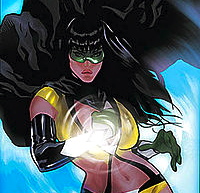
Hero Worship – Phantom Lady
One of our older comic women is Phantom Lady, who appeared in Police Comics in 1941. Busty and barely dressed, she set the stage for later sexy superheroes. Her alter ego was Sandra Knight and she switched from a skimpy blue outfit to a skimpy yellow outfit while appearing in early comics. After early appearances for Fox Features, Ajax Farrell Publications, and Charlton Comics, she was acquired by and went to work for DC Comics in 1956. Later she became Delilah Tyler (1989), and then Stormy Knight (2006). Music is Franz Schubert’s “Ständchen.”
 Phantom Lady (Stormy Knight) Promotional interior art for Uncle Sam and the Freedom Fighters #4 (Oct. 2006), by Daniel Acuña
Phantom Lady (Stormy Knight) Promotional interior art for Uncle Sam and the Freedom Fighters #4 (Oct. 2006), by Daniel Acuña
Phantom Lady is a fictional superheroine, one of the first female superhero characters to debut in the 1940s Golden Age of Comic Books. Originally published by Quality Comics, the character was subsequently published by a series of now-defunct comic book companies, and a new version of the character currently appears in books published by DC Comics.
As published by Fox Feature Syndicate in the late 1940s, the busty and scantily-clad Phantom Lady is a notable and controversial example of “good girl art,” a style of comic art depicting voluptuous female characters in provocative situations and pin-up poses that contributed to widespread criticism of the medium’s effect on children. Phantom Lady was created by the Eisner & Iger studio, one of the first to produce comics on demand for publishers. The character’s early adventures were drawn by Arthur Peddy. The character was ranked 49th in Comics Buyer’s Guide‘s “100 Sexiest Women in Comics” list.
Character origin and early publication history
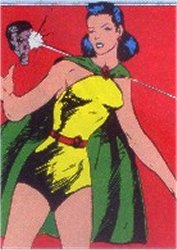 Panel from Quality Comics ‘Police Comics, depicting Phantom Lady’s black ray gun
Panel from Quality Comics ‘Police Comics, depicting Phantom Lady’s black ray gun
Quality Comics
Phantom Lady first appeared in Quality’s Police Comics #1 (Aug, 1941), an anthology title the first issue of which also included the debut of characters such as Plastic Man and the Human Bomb. That issue established her alter ego as Sandra Knight, the beautiful Washington, D.C. debutante daughter of U.S. Senator Henry Knight. The issue established that it was not her first appearance as the Phantom Lady, but it did not go into her origin. Stories published decades later by DC Comics would give her a proper origin, which was altered several times to give Sandra a more active role. Her skimpy costume was eventually explained as a deliberate tactic to distract her usually male foes.
Sandra Knight assumed the identity of Phantom Lady in a costume consisting of a green cape and the equivalent of a one-piece yellow swimsuit. She used a “black light projector,” a device which allowed her to blind her enemies and make herself invisible. She drove a car whose headlights also projected black light when necessary. She was sometimes assisted by her fiance, Donald Borden, an agent of the U.S. State Department.
Phantom Lady ran as one of the features in Police Comics through #23. Arthur Peddy continued as the artist through #13, with Joe Kubert drawing her feature in Police Comics #14-16; Frank Borth on #17-21; Arthur Peddy returned for #22,; and Rudy Palais on #23. Phantom Lady also appeared in Feature Comics #69-71 as part of a crossover with Spider Widow and the Raven.
Fox Feature Syndicate & Star Publications
After Quality stopped publishing the adventures of Phantom Lady, what was now simply Iger Studios believed it owned the character and assigned it to Fox Feature Syndicate, a move that would later cause confusion as to who actually owned the character’s copyright. The Fox version which premiered in Phantom Lady #13 (taking over the numbering of Wotalife Comics) is better known to contemporary comic fans than the Quality version because of the “good girl art” of Matt Baker. Baker altered her costume by changing the colors to red and blue, substantially revealing her cleavage, and adding a very short skirt. Fox published Phantom Ladyonly through issue 23 (Apr, 1949), though the character guest starred in All-Top Comics #8-17, also with art by Baker. Her rogue’s gallery in these two Fox titles included the Avenging Skulls; the Fire Fiend; the Killer Clown; Kurtz, the Robbing Robot; the Subway Slayer; and Vulture.
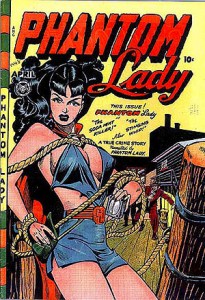 Phantom Lady vol. 1, #17 (April 1948), Fox Feature Syndicate. Cover art by Matt Baker
Phantom Lady vol. 1, #17 (April 1948), Fox Feature Syndicate. Cover art by Matt Baker
Baker’s cover for Phantom Lady #17 (Apr, 1949) was reproduced in Seduction of the Innocent, the 1954 book by Dr. Fredric Wertham denouncing what he saw as the morally corrupting effect of comics on children. The cover, which illustrated Phantom Lady attempting to escape from ropes, was presented by Wertham with a caption that read, “Sexual stimulation by combining ‘headlights’ with the sadist’s dream of tying up a woman.” In the meantime, Fox went under and its assets were acquired by other publishers, and a Phantom Lady story from All-Top was then reprinted as a backup feature in Jungle Thrills by Star Publications, which then itself went out of business.
Ajax-Farrell Publications
Ajax-Farrell Publications then published four issues of the second Phantom Lady title, cover datedDec. 1954/Jan. 1955 through June 1955. The company also published her as a backup feature in two issues of Wonder Boy.
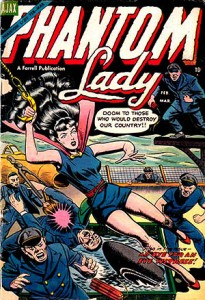 Phantom Lady vol. 2, #2 (February/March 1955) Ajax-Farrell Publications.
Phantom Lady vol. 2, #2 (February/March 1955) Ajax-Farrell Publications.
By then, Wertham’s efforts had led to a Congressional investigation into the comics industry, and publishers formed the self-censoring Comics Code Authority in the fall of 1954. Some changes were consequently made to the Phantom Lady’s costume, so that her cleavage was covered and shorts replaced her skirt.
Charlton Comics & I.W. Publications
Farrell’s assets were later acquired by Charlton Comics, and, until DC relaunched the character in the 1970s, Phantom Lady’s only appearances were in reprinted Matt Baker stories in the late 1950s and early 1960s. Israel Waldman‘s I. W. Publications (later Super Comics), a company that published unauthorized reprints from 1958–1964, included Phantom Lady reprints in issues of Great Action Comics and Daring Adventures. These comics featured new cover images of Phantom Lady that bore little visual consistency either to the Fox version of the character or each other (e.g., the character was blonde on one cover, brunette with a brown costume on another).
DC Comics – Sandra Knight
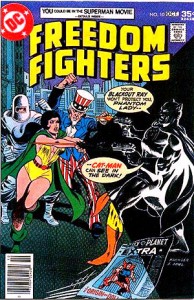 Freedom Fighters #10 (September–October 1977). Phantom Lady fights Cat-Man, with fellow Quality superheroes the Human Bomb and Uncle Sam.
Freedom Fighters #10 (September–October 1977). Phantom Lady fights Cat-Man, with fellow Quality superheroes the Human Bomb and Uncle Sam.
In 1956, DC Comics obtained the rights to the Quality Comics characters, which they believed included Phantom Lady, and reintroduced her 17 years later with a group of other former Quality heroes as the Freedom Fighters in Justice League of America #107 (Oct. 1973).
As was done with many characters DC acquired from other publishers, or that were holdovers from Golden Age titles, the Freedom Fighters were relocated to a parallel world. Their particular earth was referred to as “Earth-X“. On Earth-X, Nazi Germany had won World War II. The team was later featured in its own series for 15 issues (1976–1978), in which they temporarily left Earth-X for “Earth-1” (where most DC titles are set) and Phantom Lady was given real phantom-like powers.
During the final issue of the original Freedom Fighters series, the writers gave the character an origin story. One night, Sandra happened across two would-be assassins targeting her father, and stealthily thwarted them with nothing more than a rolled-up newspaper. Knight consequently developed a taste for adventure and crime-fighting, and after finding a “black light ray projector” that a family friend named Professor Davis sent to her father, she adopted the device as a weapon.
In 1981, Phantom Lady became a recurring guest star of All-Star Squadron, a superhero-team title set on “Earth-2“, the locale for DC’s World War II-era superheroes, and at a time prior to when she and the other Freedom Fighters were supposed to have left for Earth-X. Phantom Lady then appeared with the rest of DC’s superheroes in Crisis on Infinite Earths, a story that was intended to eliminate the confusing histories that DC had attached to its characters by retroactively merging the various parallel worlds into one. This left Phantom Lady’s Earth-X days written out of her history, and the Freedom Fighters became a mere splinter group of the All-Star Squadron.
DC also retconned the origin of Phantom Lady established in Quality’s Police Comics, so that she now belonged to the prestigious Knight family of Opal City, a locale central to DC’s Starman line of heroes. Her formative story was changed so that she overtook her father’s would-be assassins with her fists instead of a newspaper. Lastly, she was given a more active role in the acquisition of her black light ray, which she no longer received from a mere family friend but instead from a scientist named Dr. Abraham Davis, who had escaped from Nazi-controlled Europe. In the retelling, Sandra Knight gave asylum to Davis, setting him up in a laboratory and helping him to complete his invention. Ted Knight, now established as her cousin, also aided Davis, as a result acquiring the technology that allowed him to become the first Starman.
The 1994 title Damage established the post-World War II history for Phantom Lady. She was made an agent of a Cold War-era government intelligence agency called Argent, in which she met and married fellow former-All Star Squadron member Iron Munro (a character introduced in the 1986 series Young All-Stars). The two were paired on several missions and fought a Soviet-backed agent named The Baron, actually the German Baron Blitzkrieg, a foe both had met during World War II. Shortly after becoming pregnant, Sandra was kidnapped by The Baron who stole the fetus from her womb and left her for dead. After escaping from Communist Poland, Sandra wanted out of the spy game and turned to an old friend, Roy Lincoln. He helped her, and soon thereafter she started the Universite Notre Dame Des Ombres (the University of Our Lady of the Shadows) in the hopes of making further intelligence contacts and finding her baby; unfortunately, she was not successful. Phantom Lady’s presence in the U.S. and her work with American Intelligence was kept a secret to most; she never reunited with her husband, and in her old age became headmistress of the school she began, now a training center for female spies in Washington, D.C.
In Manhunter #23 (June, 2006), Phantom Lady met the current Manhunter, Kate Spencer, and it was revealed that she was Spencer’s grandmother. Phantom Lady and Iron Munro were revealed to have had a child before their marriage whom they gave up for adoption—Walter Pratt, Spencer’s father. The Golden Age Atom, Al Pratt, had allowed Phantom Lady to use his contact information so that she could get into a home for unwed mothers, causing the belief that the child was Pratt’s son. Knight and Munro still keep in contact, as she brought him to meet Kate and her son, Ramsey.
Dee Tyler
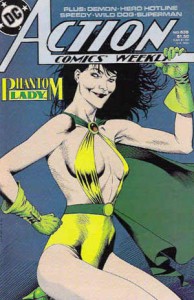 Dee Tyler as the Phantom Lady on the cover of Action Comics Weekly #639. Art by Kevin Nowlan.
Dee Tyler as the Phantom Lady on the cover of Action Comics Weekly #639. Art by Kevin Nowlan.
A second Phantom Lady, Delilah “Dee” Tyler, was introduced in Action Comics Weekly #636 (January, 1989) and was given a back-up feature in that title through #641 with art by Chuck Austen. The daughter of the U.S. Attorney General, Tyler was trained by the original Phantom Lady, the now-elderly Sandra Knight, at the exclusive Université Notre Dame des Ombres (Our Lady of the Shadows) in France. She inherited Knight’s equipment and costume.
It was heavily implied in that series that she was not alone in being thus trained and equipped, as her “college roommate” Marie Saloppe also appeared in the guise of Phantom Lady in Action Comics Weekly #639. Tyler’s primary ability was an extensive knowledge of the martial art called Savate, also known as French kickboxing. She also possessed a wrist-mounted blaster, and a holographic projector developed by her childhood friend and roommate Sarah that could be used to cast powerful illusions.
This successor Phantom Lady never received a series of her own, but was a periodic guest star in other titles, including the 1988 Starman, Flash, and most frequently in the 1994 Starman title. She joined a new version of the Freedom Fighters in the 1999 JSA series.
The character was graphically killed (along with at least two other Freedom Fighters) in Infinite Crisis#1 (Dec, 2005), in a battle against the Society. The group was ambushed while investigating the meeting place of other supervillains. Tyler was wounded by the Cheetah and then fatally impaled by Deathstroke. Her body was hung on the Washington Monument along with the Human Bomb and Black Condor. In Blackest Night crossover, Tyler was reanimated as a member of the Black Lantern Corps.

